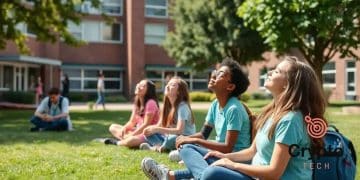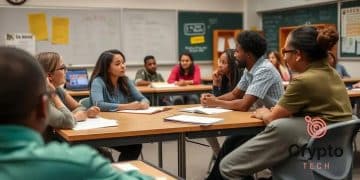Is the Federal School Voucher Program the Future of Education or a Threat to Public Schools?

The Federal school voucher program is changing how families access education in the U.S., giving parents the power to direct public funds toward private schooling. This shift aims to expand learning opportunities beyond traditional public systems.
Instead of being limited by ZIP codes or district lines, many families now explore options that better match their values, academic needs, or learning styles. It’s a reimagining of what “public support” in education can look like.
Curious how this affects your child’s future or your community’s schools? Understanding this initiative is key to navigating the evolving landscape of American education.
Understanding the federal school voucher program
The Federal school voucher program is a national initiative that aims to expand educational access by giving families greater control over where and how their children learn.
Instead of being restricted to public schools assigned by geographic zones, parents can apply government-funded vouchers toward tuition at private, charter, or other approved non-public schools.
The program’s goal is to empower families, especially those from underserved communities, with choices that better reflect their values and their children’s unique educational needs.
This approach redefines the use of public funds in education. Rather than supporting institutions directly, the funding follows the student.
Proponents argue that this shift promotes flexibility, innovation, and responsiveness in education, creating a more competitive environment that benefits families seeking alternatives to underperforming schools.
Understanding the Federal school voucher program involves exploring its impact on educational equity, public funding, and the broader structure of American schooling.
As more states adopt or expand similar models, the conversation around who benefits, and at what cost, continues to grow.
What Is a School Voucher?
At its core, a school voucher is a government-issued certificate or credit that allows families to redirect public education funds toward tuition at a school of their choosing.
These funds typically cover part or all of the tuition at eligible private or charter institutions, and may also include related costs like transportation or special education services, depending on the state.
The Federal school voucher program supports this model at the national level, particularly benefiting low-income or disadvantaged families who might otherwise lack access to high-quality education.
Eligibility criteria often vary, but the intention remains the same: to bridge gaps in opportunity by putting educational decisions into parents’ hands.
By providing a financial mechanism to access schools outside the public system, vouchers aim to diversify the educational landscape and enable customized learning experiences tailored to a child’s academic strengths and personal needs.
Key Features of the Federal School Voucher Program
One of the standout features of the Federal school voucher program is its emphasis on financial access.
Vouchers serve as a crucial tool for families seeking alternatives to underfunded or overcrowded public schools, giving them a chance to choose institutions that align with their goals, be it academic rigor, specialized curricula, or cultural fit.
School choice is a foundational principle of the program. Parents no longer have to settle for schools based solely on district lines or zip codes.
With the aid of vouchers, they can explore a variety of educational settings, including religious schools, STEM-focused academies, or institutions with smaller class sizes and individualized instruction.
Participating schools are often required to meet transparency and performance benchmarks. Though accountability standards differ by region, the program generally mandates some form of academic oversight to ensure educational quality.
This fosters a climate of competition, encouraging schools, public and private alike, to raise their standards and innovate to attract students.
Key benefits of school vouchers
School vouchers provide a range of advantages that can enhance educational experiences for students. Through school vouchers, families gain access to a variety of educational opportunities that may better meet their children’s unique needs.
One of the primary benefits of utilizing school vouchers is the increased choice for families. Parents can select schools that align with their educational preferences and values.
This flexibility allows them to prioritize quality education, specialized programs, and individual learning environments.
- Customization of Education: With vouchers, families can choose schools that cater to specific learning styles.
- Access to Better Resources: Many private schools have access to more funding, allowing for improved facilities and programs.
- Reduced Class Sizes: Private schools often have smaller classes, which can lead to more personalized attention.
The potential for improved academic performance is significant. Studies often indicate that students using school vouchers tend to perform better academically compared to their peers in traditional public schools.
This increase in performance can be attributed to various factors such as enhanced accountability and competition among schools.
Another advantage is the opportunity for families to choose institutions that focus on particular areas of study or values, such as religious education or STEM programs.
This personalized approach can lead to higher student engagement and motivation.
Furthermore, the competition introduced by school vouchers creates incentives for public schools to enhance their offerings.
As parents weigh their options, schools may strive to improve their curriculum, teaching methods, and overall student services to attract enrollments.
Challenges faced by the voucher system

While the Federal school voucher program presents a promising path for expanding educational choice, it also brings complex challenges that demand careful evaluation.
Supporters highlight its potential to uplift underserved communities, but critics point to structural flaws that may deepen existing disparities if left unaddressed.
Balancing innovation with equity remains a central issue in the program’s implementation and future development.
Inequities in Access
Access to the Federal school voucher program is not uniformly distributed. Families in rural or economically depressed areas often lack a range of private or charter school options, making vouchers practically unusable.
Even when alternatives exist, transportation barriers, limited seats, and application requirements may prevent lower-income families from taking full advantage of the system.
Additionally, many private institutions are selective in their admissions processes. This creates a situation where vouchers alone are not enough; a student may be unable to enroll if the school doesn’t accept them or lacks adequate support services.
As a result, families with more resources or awareness are more likely to navigate the system successfully, reinforcing a cycle of inequality.
The Biden administration has faced ongoing pressure from both sides of the debate.
A 2024 report from Education Week highlighted concerns that voucher expansion could widen achievement gaps unless paired with strong accountability and inclusive access strategies
Potential for Resource Drain
A central point of contention in the Federal school voucher program is its impact on public school funding.
Because vouchers redirect public dollars to private institutions, traditional public schools often see a decrease in financial support.
This poses a direct threat to schools already grappling with tight budgets and under-resourced classrooms, especially in high-need districts.
The loss of students and accompanying funds can lead to larger class sizes, reduced programs, and staff layoffs.
In the long term, this dynamic risks creating a two-tier education system, one where families with access to better options continue to rise, while those left behind face deteriorating public services.
Although competition is intended to raise performance across the board, it can backfire if not managed with equity in mind.
Another concern is the uneven oversight of voucher-accepting institutions. Unlike public schools, many private schools are not subject to the same academic and financial reporting requirements.
Without standardized regulation, disparities in educational quality may grow. This inconsistency leads some experts to question whether the outcomes truly justify the investment, especially when public dollars are involved.
Success stories from voucher users
There are many inspiring success stories from families who have utilized the school voucher program. These narratives reflect the positive impact that vouchers can have on students’ educational experiences and outcomes.
One common theme among voucher users is the ability to access educational environments that fit their specific needs. For instance, a family in Texas was able to use a voucher to enroll their son in a specialized school that focuses on dyslexia education.
With tailored teaching methods, the student’s reading skills improved significantly, boosting both his confidence and academic performance.
- Extracurricular Activities: Many voucher students have gained access to diverse extracurricular options that were unavailable at public schools.
- Scholarship Programs: Families have successfully combined vouchers with scholarships, allowing them to attend elite private schools.
- Academic Achievements: Several students have reported higher test scores and grades after switching to schools that better align with their learning styles.
Another success story involves a single mother from Florida who found it difficult to afford quality education for her children. After receiving a voucher, she enrolled her daughters in a performing arts academy.
The exposure to the arts not only enhanced their schooling but also instilled a love for learning. Both girls went on to receive scholarships to prestigious universities.
Success stories like these demonstrate how the voucher program can create pathways for educational advancement.
Many families have reported greater satisfaction with their children’s education and overall well-being after switching schools. These positive outcomes are powerful testimonies to the potential advantages of school vouchers.
Future of federal school vouchers
The future of federal school vouchers is a topic of much debate and potential evolution. As education continues to change, the role of vouchers may also adapt to meet new challenges and needs.
More families are becoming aware of the choices that school vouchers can provide. This growing acceptance may lead to an increase in demand for voucher programs across the nation.
As awareness rises, policymakers may feel pressured to expand these programs to accommodate families seeking better educational options for their children.
Potential Policy Changes
- State Initiatives: States are likely to create or modify their voucher programs, tailoring them to local needs.
- Federal Legislation: There may be new federal policies that further support or regulate voucher systems, aiming to improve equity.
- Increased Funding: Potential funding increases could help address concerns about public school resource drain and provide more equitable options.
Experts believe that the future could see a stronger alignment between vouchers and educational outcomes.
As data from existing programs become available, there may be a push to refine voucher criteria to ensure that students are receiving quality education. This might lead to a more results-focused approach in how these programs are implemented.
Furthermore, technological advancements could influence the future of school vouchers. Online education and hybrid models may become integral to how vouchers are used.
Students might have access to new forms of educational delivery that can be funded through vouchers, creating a more flexible and personalized learning environment.
Ultimately, the future of federal school vouchers holds many possibilities. As families advocate for better educational outcomes, the voucher system may evolve to create equitable, high-quality education choices for all students.
Did you enjoy the content? Also read “Impact of Federal Education Reforms on Minority Students“.
FAQ – Frequently Asked Questions about the Federal School Voucher Program
What is the purpose of the federal school voucher program?
The purpose of the federal school voucher program is to provide families with the financial resources to choose educational options that best fit their children’s needs.
How do school vouchers work?
School vouchers are certificates that allow parents to use public funding for private or alternative school tuition, giving them more control over their children’s education.
What challenges do families face when using school vouchers?
Families may face challenges such as limited access to quality schools, lack of information about available options, and potential gaps in resources for public schools.
Are there any success stories from the school voucher program?
Yes, many families have shared stories of improved academic performance and satisfaction after using vouchers to access tailored educational environments.





